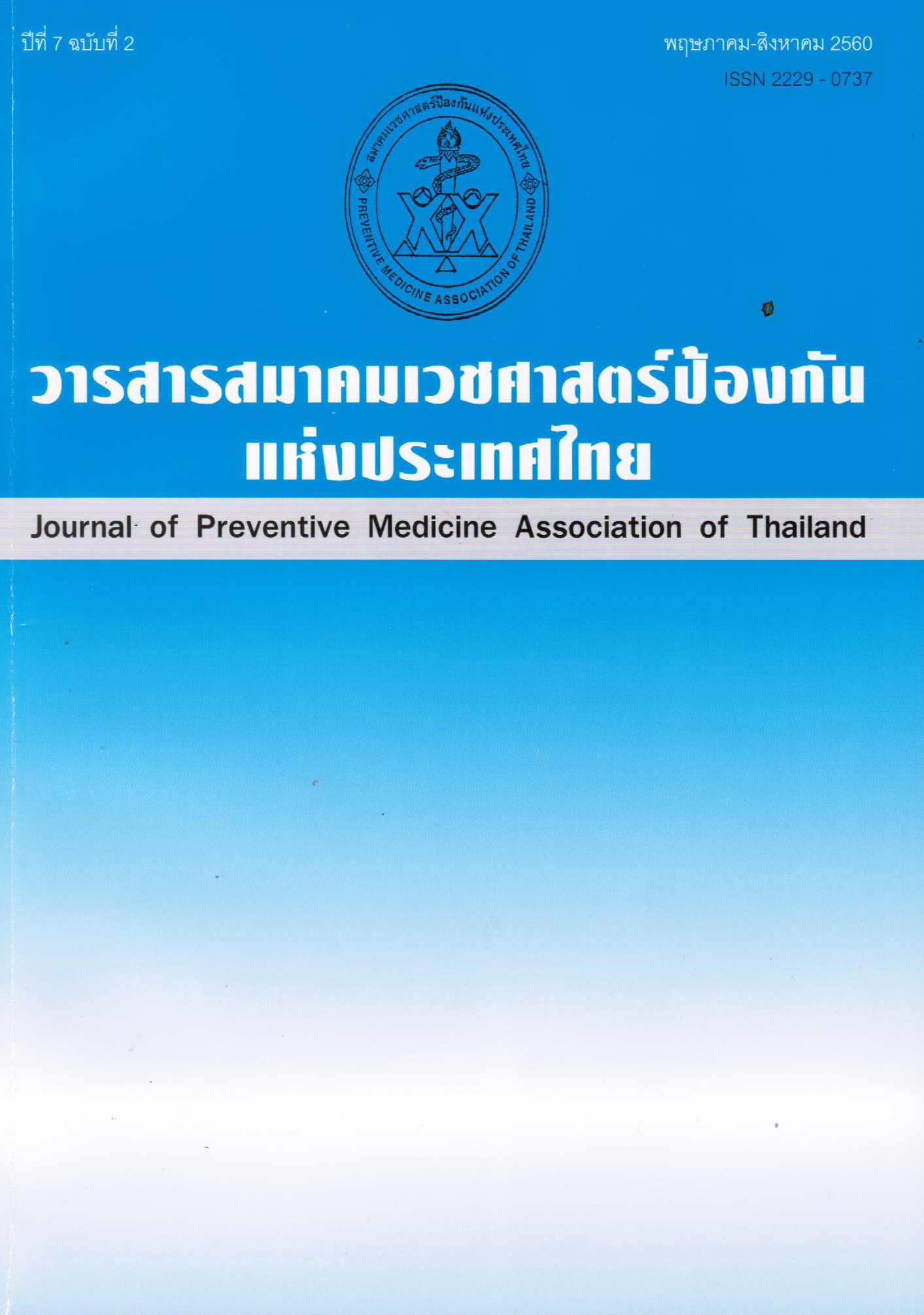Prevalence and Associated Factors of Hand Contact Dermatitis Among Food Handlers in Department of Medical Service Hospitals and Hospitals in the Central Region of Thailand
Keywords:
Prevalence, Hand dermatitis, Occupational contact dermatitis, Food handlerAbstract
This study aimed to find out the prevalence and associated factors of hand contact dermatitis among food handlers in Department of Medical Service Hospitals and Hospitals in the Central Region of Thailand. The study design was a cross-sectional descriptive study; subjects were hospital personnel from 10 institutes, a total of 264 handlers. The data was collected by questionnaires, adapted from Nordic Occupational Skin Questionnaire, about personal factors,
occupational factors, hobby and domestic work factors, environmental factors and history of hand dermatitis. Individual subjects’ hands were examined and photographed about their skin lesions for hand dermatitis, approved by dermatologist. The results found that prevalence of hand contact dermatitis was 11.0%. Significant factors associated with hand contact dermatitis were aging, history of atopic dermatitis and routine activities, including preparing food and
washing. Other factors such as environmental and hobby or domestic work, are not associated with hand contact dermatitis. In addition, the data showed that some participants had hand problems after exposed to chemical agents at work. In conclusion, ways to reduce hand contact dermatitis problems include health education, awareness of hand care, avoid chemical exposure as needed, appropriate PPE use, good hygiene care and may adapt working activities
for food handlers. These will diminish illness and health care burden. Furthermore, it will be beneficial to in-patients at the hospital in the aspect of food safety.
References
2. สำนักงานประกันสังคม กระทรวงแรงงาน. สถิติการเกิดโรคจากการทำงานในประเทศไทยปี พ.ศ. 2551. กรุงเทพมหานคร: สำนักงานประกันสังคม; 2551.
3. ประณีต สัจจเจริญพงษ์. โรคผิวหนังจากการทำงาน. ใน: อดุลย์ บัณฑุกุล, บรรณาธิการ. ตำราอาชีวเวชศาสตร์ (Textbook of occupational medicine). กรุงเทพมหานคร: โรงพยาบาลนพรัตนราชธานี กรมการแพทย์ กระทรวงสาธารณสุข; 2554. หน้า 667-89.
4. พิชญา พรรคทองสุข, ชูวัตร ตันติโกศล, สมเกียรติ ศิริรัตนพฤกษ์, วิโรจน์ เจียมจรัสรังษี, ชนนท์ กองกมล. โรคผิวหนังที่มีสาเหตุมาจากการประกอบอาชีพ. ใน: สำนักโรคจากการประกอบอาชีพและสิ่งแวดล้อม กรมควบคุมโรค กระทรวงสาธารณสุข. แนวทางการวินิจฉัยโรคและภัยจากการประกอบอาชีพเบื้องต้น สำหรับหน่วยบริการสาธารณสุข. พิมพ์ครั้งที่ 2. กรุงเทพมหานคร: โรงพิมพ์ชุมนุมสหกรณ์การเกษตร แห่งประเทศไทย; 2555. หน้า 2-8.
5. Fowler JF, Ghosh A, Sung J, Emani S, Chang J, Den E, Thorn D, et al. Impact of chronic hand dermatitis on quality of life, work productivity, activity impairment, and medical costs. J Am Acad Dermatol 2006;54(3):448-57.
6. Mollerup A, Veien NK, Johansen JD. An analysis of gender differences in patients with hand eczema-everyday exposures, severity, and consequences. Contact dermatitis 2014;71(1):21-30.
7. Meding B, Swanbeck G. Consequences of having hand eczema. Contact dermatitis 1990;23(1):6-14.
8. Vester L, Thyssen JP, Menne T, Johansen JD. Consequences of occupational food-related hand dermatoses with a focus on protein contact dermatitis. Contact dermatitis 2012;67(6): 328-33.
9. Cvetkovski RS, Rothman KJ, Olsen J, Mathiesen B, Iversen L, Johansen JD, Agner T. Relation between diagnoses on severity, sick leave and loss of job among patients with occupational hand eczema. Br J Dermatol 2005;152(1):93-8.
10. ปิยะ แซ่จัง, สุนทร ศุภพงษ์. ความชุกและปัจจัยที่เกี่ยวข้องกับการเกิดผื่นผิวหนังอักเสบบริเวณมือในนักศึกษาช่างทำผมหญิงในเขตกรุงเทพมหานคร. วารสารควบคุมโรค
2555;38(2):77-86.
11. สัจจพล พงษ์ภมร. ผื่นแพ้สัมผัสจากการทำงานในแม่บ้านทำความสะอาดของโรงพยาบาลรัฐบาลสังกัด กรมการแพทย์. วารสารสมาคมเวชศาสตร์ป้องกันแห่งประเทศไทย 2554;1(2):153-65.
12. Crawford GH, Katz KA, Ellis E, James WD. Use of aromatherapy products and increased risk of hand dermatitis in massage therapists. Arch Dermatol 2004;140:991-6.
13. Gawkrodger DJ, Lloyd MH, Hunter JA. Occupational skin disease in hospital cleaning and kitchen workers. Contact dermatitis 1986;15(3):132-5.
14. Luebberding S, Krueger N, Kerscher M. Age-related changes in skin barrier function- quantitative evaluation of 150 female subjects. Int J Cosmet Sci 2013;35(2):183-90.
15. Bauer A, Bartsch R, Hersmann C, Stadeler M, Kelterer D, Schneider W, et al. Occupational hand dermatitis in food industry apprentices: results of a 3-year follow-up cohort study. Int Arch Occup Environ Health 2001;74(6):437-42.
16. Bryld LE, Hindsberger C, Kyvik KO, Agner T, Menne T. Risk factors influencing the development of hand eczema in a population-based twin sample. Br J Dermatol
2003;149:1214-20.
17. Heede NG, Thyssen JP, Thuesen BH, Linneberg A, Johansen JD. Predictive factors of self-reported hand eczema in adult Danes: a population-based cohort study with 5-year follow-up. Br J Dermatol 2016;175(2):287-95.
18. Behroozy A, Keegel TG. Wet-work Exposure: A Main Risk Factor for Occupational Hand Dermatitis. Saf Health Work 2014;5(4):175-80.
19. Tiedemann D, Clausen ML, John SM, Angelova-Fischer I, Kezic S, Agner T. Effect of glove occlusion on the skin barrier. Contact dermatitis 2016;74(1):2-10.
20. Fartasch M. Wet Work and Barrier Function. Curr Probl Dermatol 2016;49:144-51.
21. Callahan A, Baron E, Fekedulegn D, Kashon M, Yucesoy B, Johnson VJ, et al. Winte season, frequent hand washing, and irritant patch test reactions to detergents are associated with hand dermatitis in health care workers. Dermatitis : contact, atopic, occupational, drug 2013;24(4):170-5.
22. Teo S, Teik-Jin Goon A, Siang LH, Lin GS, Koh D. Occupational dermatoses in restaurant, catering and fast-food outlets in Singapore. Occupational medicine (Oxford,
England) 2009;59(7):466-71.
23. Mahler V. Occupational contact dermatitis: chefs and food handlers. In: Johansen JD, Frosc PJ, Lepoittevin JP, editors. Contact dermatitis. 5th ed. Berlin: Springer; 2011.p.853-64.
24. Lee A, Nixon R, Frowen K. Reduction of use of latex gloves in food handlers: an intervention study. Contact Dermatitis 2001;44:75-9.
25. Uter W, Gefeller O, Schwanitz HJ. An epidemiological study of the influence of season (cold and dry air) on the occurrence of irritant skin changes of the hands. Br J Dermatol 1998;138:266-72.
26. Engebretsen KA, Johansen JD, Kezic S, Linneberg A, Thyssen JP. The effect of environmental humidity and temperature on skin barrier function and dermatitis. J Eur Acad Dermatol Venereol 2016;30(2):223-49.
Downloads
Published
How to Cite
Issue
Section
License
บทความที่ลงพิมพ์ในวารสารเวชศาสตร์ป้องกันแห่งประเทศไทย ถือเป็นผลงานวิชาการ งานวิจัย วิเคราะห์ วิจารณ์ เป็นความเห็นส่วนตัวของผู้นิพนธ์ กองบรรณาธิการไม่จำเป็นต้องเห็นด้วยเสมอไปและผู้นิพนธ์จะต้องรับผิดชอบต่อบทความของตนเอง






